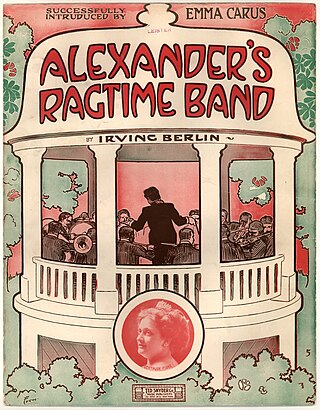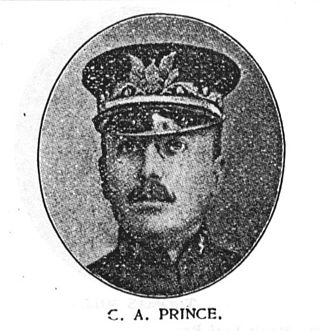Ragtime, also spelled rag-time or rag time, is a musical style that had its peak from the 1890s to 1910s. Its cardinal trait is its syncopated or "ragged" rhythm. Ragtime was popularized during the early 20th century by composers such as Scott Joplin, James Scott and Joseph Lamb. Ragtime pieces are typically composed for and performed on piano, though the genre has been adapted for a variety of instruments and styles.

Scott Joplin was an American composer and pianist. Dubbed the "King of Ragtime", he composed more than 40 ragtime pieces, one ragtime ballet, and two operas. One of his first and most popular pieces, the "Maple Leaf Rag", became the genre's first and most influential hit, later being recognized as the quintessential rag. Joplin considered ragtime to be a form of classical music meant to be played in concert halls and largely disdained the performance of ragtime as honky tonk music most common in saloons.

"Alexander's Ragtime Band" is a Tin Pan Alley song by American composer Irving Berlin released in 1911; it is often inaccurately cited as his first global hit. Despite its title, the song is a march as opposed to a rag and contains little syncopation. The song is a narrative sequel to Berlin's earlier 1910 composition "Alexander and His Clarinet". This earlier composition recounts the reconciliation between an African-American musician named Alexander Adams and his flame Eliza Johnson as well as highlights Alexander's innovative musical style. Berlin's friend Jack Alexander, a cornet-playing African-American bandleader, inspired the title character.

James Hubert "Eubie" Blake was an American pianist and composer of ragtime, jazz, and popular music. In 1921, he and his long-time collaborator Noble Sissle wrote Shuffle Along, one of the first Broadway musicals written and directed by African Americans. Blake's compositions included such hits as "Bandana Days", "Charleston Rag", "Love Will Find a Way", "Memories of You" and "I'm Just Wild About Harry". The 1978 Broadway musical Eubie! showcased his works, and in 1981, President Ronald Reagan awarded Blake the Presidential Medal of Freedom.

The United States' multi-ethnic population is reflected through a diverse array of styles of music. It is a mixture of music influenced by the music of Europe, Indigenous peoples, West Africa, Latin America, Middle East, North Africa, amongst many other places. The country's most internationally renowned genres are traditional pop, jazz, blues, country, bluegrass, rock, rock and roll, R&B, pop, hip-hop/rap, soul, funk, religious, disco, house, techno, ragtime, doo-wop, folk, americana, boogaloo, tejano, reggaeton, surf, and salsa, amongst many others. American music is heard around the world. Since the beginning of the 20th century, some forms of American popular music have gained a near global audience.

Artie Matthews was an American songwriter, pianist, and ragtime composer.
Marabi is a style of music that evolved in South Africa in the 1920s.

Noble Lee Sissle was an American jazz composer, lyricist, bandleader, singer, and playwright, best known for the Broadway musical Shuffle Along (1921), and its hit song "I'm Just Wild About Harry".

The latter part of the 19th century saw the increased popularization of African American music and the growth and maturity of folk styles like the blues.
The music of Baltimore, the largest city in Maryland, can be documented as far back as 1784, and the city has become a regional center for Western classical music and jazz. Early Baltimore was home to popular opera and musical theatre, and an important part of the music of Maryland, while the city also hosted several major music publishing firms until well into the 19th century, when Baltimore also saw the rise of native musical instrument manufacturing, specifically pianos and woodwind instruments. African American music existed in Baltimore during the colonial era, and the city was home to vibrant black musical life by the 1860s. Baltimore's African American heritage to the start of the 20th century included ragtime and gospel music. By the end of that century, Baltimore jazz had become a well-recognized scene among jazz fans, and produced a number of local performers to gain national reputations. The city was a major stop on the African American East Coast touring circuit, and it remains a popular regional draw for live performances. Baltimore has produced a wide range of modern rock, punk and metal bands and several indie labels catering to a variety of audiences.
This is a timeline of music in the United States prior to 1819.
This is a timeline of music in the United States from 1950 to 1969.
This is a timeline of music in the United States from 1970 to the present.
This is a timeline of music in the United States from 1820 to 1849.
This timeline of music in the United States covers the period from 1850 to 1879. It encompasses the California Gold Rush, the Civil War and Reconstruction, and touches on topics related to the intersections of music and law, commerce and industry, religion, race, ethnicity, politics, gender, education, historiography and academics. Subjects include folk, popular, theatrical and classical music, as well as Anglo-American, African American, Native American, Irish American, Arab American, Catholic, Swedish American, Shaker and Chinese American music.
This is a timeline of music in the United States from 1920 to 1949.

Slave Songs of the United States was a collection of African American music consisting of 136 songs. Published in 1867, it was the first, and most influential, collection of spirituals to be published. The collectors of the songs were Northern abolitionists William Francis Allen, Lucy McKim Garrison, and Charles Pickard Ware. The group transcribed songs sung by the Gullah Geechee people of Saint Helena Island, South Carolina. These people were newly freed slaves who were living in a refugee camp when these songs were collected. It is a "milestone not just in African American music but in modern folk history". It is also the first published collection of African-American music of any kind.

Charles Adams Prince was an American conductor, bandleader, pianist and organist known for conducting the Columbia Orchestra and, later, Prince's Band and Orchestra. He made his first recordings, as a pianist, in 1891 for the New York Phonograph Company. Later in the 1890s he worked as a musical director for Columbia Records. He also conducted the Columbia Orchestra and Columbia Band starting in 1904 as the successor of the cornetist Tom Clark.
Wallie Herzer(néWalter Henry Herzer; 15 April 1885 San Francisco – 15 October 1961 Redwood City, California) was an American composer of popular music, music publisher, and pianist. Herzer flourished in music prior to and during World War I.








